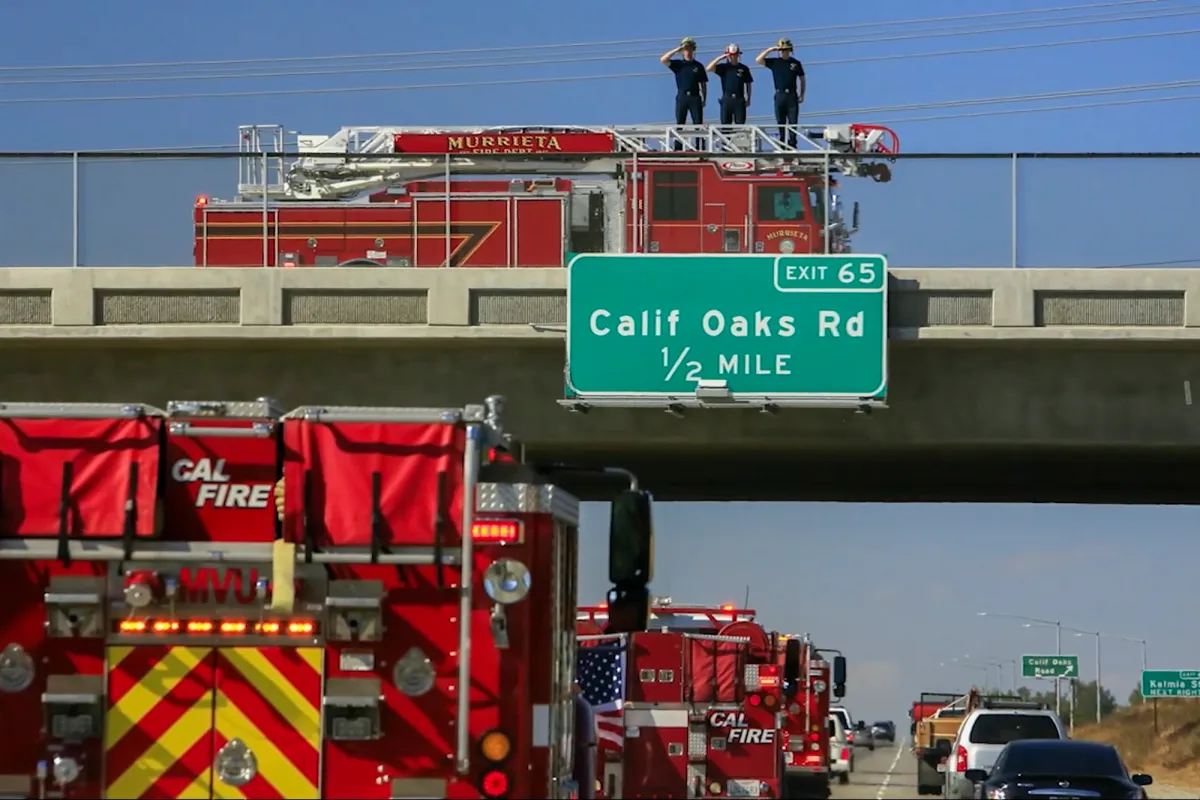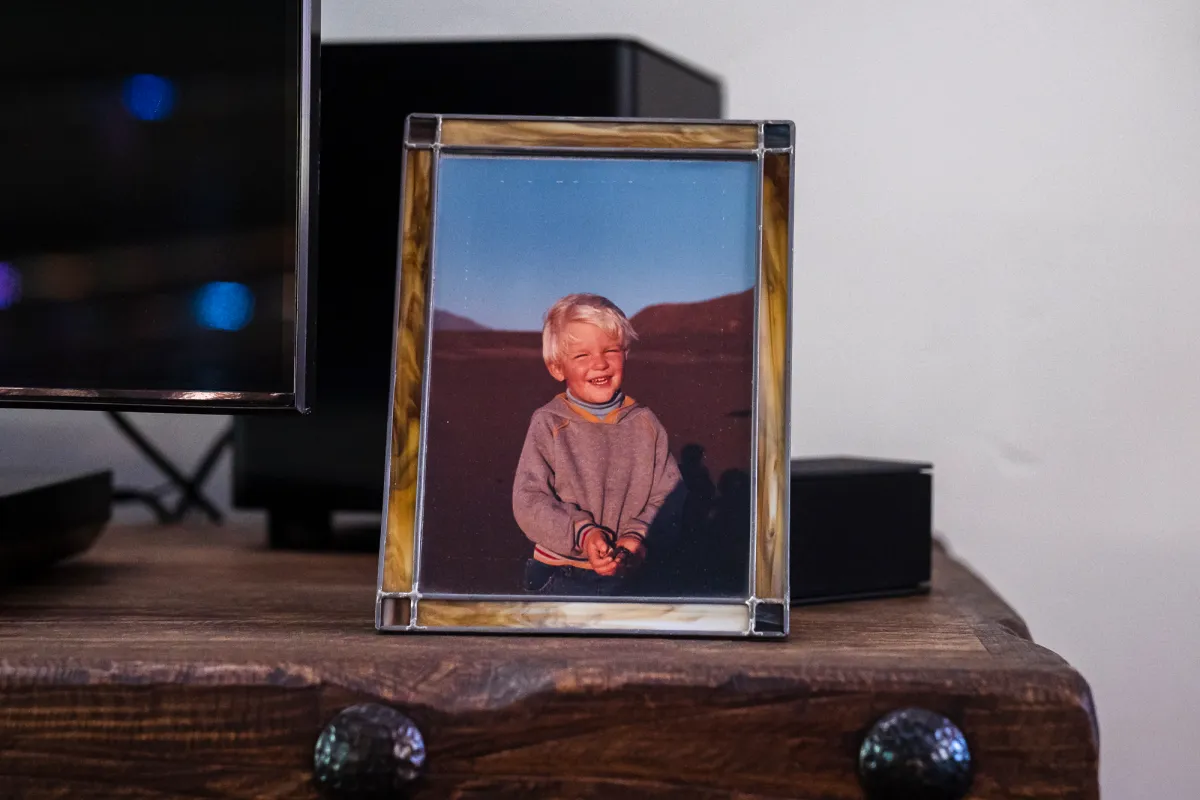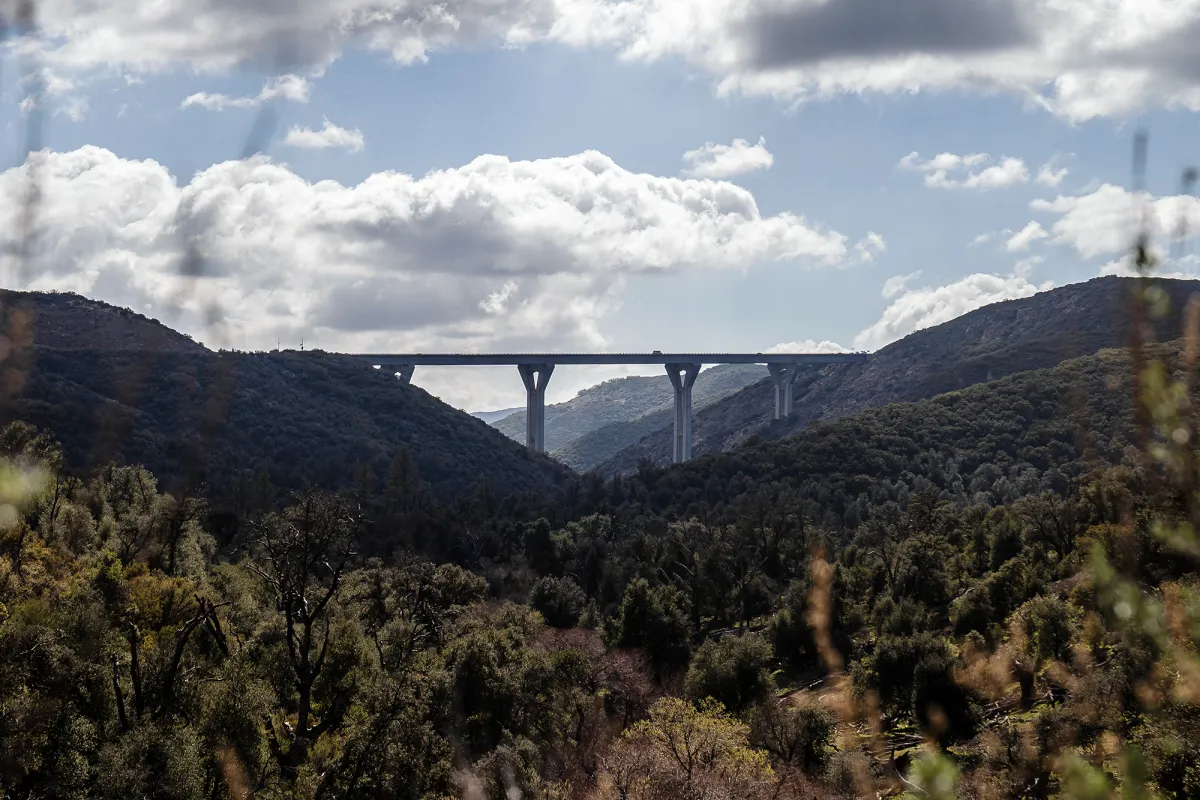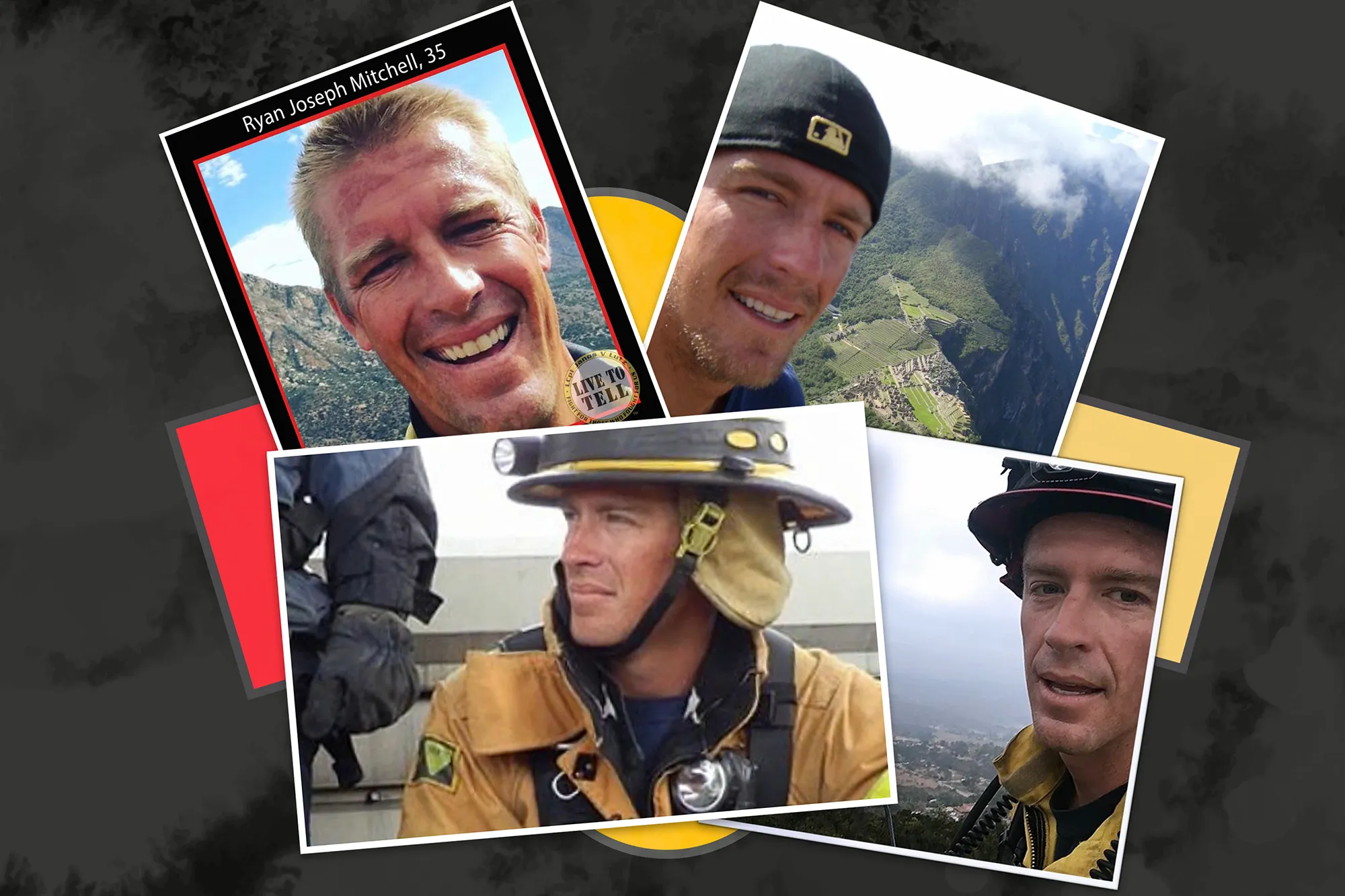Reliving Ryan’s story: A hard-charging California firefighter loses his last battle to suicide
Love your friends love your family and help those in need, this is the way of the Lord, your God!
IN SUMMARY
Strong and stoic, a Cal Fire captain fought wildland fires and helped retrieve the bodies of despondent people who had jumped off a remote bridge. When the bridge beckoned him, he couldn’t keep fighting.
He was Superman. A skilled surfer, skateboarder and hockey defenseman. A leader much admired and sometimes resented. He was hard-charging, driven by the motto of his unit: “Lead, follow, or get out of the way.”
Cal Fire Captain Ryan Mitchell was the embodiment of the heroic archetype: 6–foot-4, strong and stoic, brave in the face of danger, the last person anyone expected to take his own life.
Until he did.
On that bright November morning, Mitchell cleared up the paperwork at the end of his shift, locked the bay doors at Station 20 in El Cajon and set out to put an end to his pain.
He drove half an hour through picturesque rolling hills to a remote bridge in San Diego County and pulled off to the side of the road. Nearby, large public-service signs urged anyone considering suicide to call a toll-free number.
Mitchell got out of his car, walked onto the Pine Valley Creek Bridge and stepped off the 440-foot-high span. He was 35 years old.
One of many
It was 2017, and Mitchell was one of at least 117 firefighters across the country who took their own lives that year, according to the Firefighter Behavioral Health Alliance, the only national organization that tracks such figures.
Although there are ample anecdotal stories about suicides among California firefighters, there is no data detailing the scope of the problem at Cal Fire. National data also is sparse, but suicides appears to be increasing nationwide: The alliance has verified 1,750 firefighter suicides since 1880, with 95% of the deaths occurring between 2000 and 2022. Jeff Dill, a retired fire chief who founded the alliance, estimates that only about a third of firefighter suicides are identified because of the social stigma and code of silence.
“I can’t tell you how many coworkers and longtime friends have killed themselves, and four times as many have attempted it in the last few years.”
TONY MARTINEZ, CAL FIRE CAPTAIN IN NAPA COUNTY
The statistics paint a grim picture: Desperate firefighters turn guns on themselves or drive into trees. One jammed a stick of dynamite in his mouth and lit the fuse. Some set themselves on fire.
Tony Martinez, a Cal Fire captain in Napa County, said many coworkers have committed suicide — or attempted to, some multiple times.
“I can’t tell you how many coworkers and longtime friends have killed themselves, and four times as many have attempted it in the last few years. Three co-workers in Cal Fire died last week. Died by suicide,” Martinez said.
Finding Ryan
Cell phones began buzzing around 11 a.m. on that Sunday, when many of Mitchell’s family members and friends were at church. A phone tree began heating up with the same urgent question: “Have you heard from Ryan?”
Tony Mecham, Mitchell’s battalion chief in El Cajon, was driving back from a family emergency and left strict instructions not to be bothered. When he received two calls in five minutes, he knew it was something serious. His duty chief reached him while he was driving with his wife on a freeway in the San Fernando Valley.
“I don’t know how to tell you this, but Ryan Mitchell just jumped off the Pine Valley Bridge,” the chief told Mecham.
“I remember it as clear as day,” Mecham said. “I tried to catch my breath. I pulled over, and as my wife drove, I got on the phone and started making calls.”
The 911 calls did not identify the jumper. But once it became clear that a Cal Fire captain was involved, the tenor of the emergency response changed. In terse, tight communications, the region’s first responders moved swiftly to recover the body of a brother in uniform.
A Cal Fire division chief who knew Mitchell’s parents was dispatched to locate them; another was sent to notify Mitchell’s estranged wife, who had been looking for him when he failed to pick up his 16-month-old son. A sheriff’s deputy met Mitchell’s parents at their church.
Mecham began to manage the emotional fallout he knew was coming. It was the worst possible scenario: Mitchell’s own workmates responded to the 911 call from a citizen reporting his suicide. The crew sent to the scene had recognized Mitchell’s vehicle, a distinctive, beat-up station wagon he used when he went surfing.
Commanders took Mitchell’s fire station out of service for the day and instructed other battalion chiefs to visit every station to break the news. Local fire crews covered for Cal Fire that day.
The San Diego County Sheriff and California Highway Patrol let Cal Fire know they would handle the operation. Mecham wanted his people at the scene, but he didn’t want them to have to retrieve their co-worker’s body.

A team hiked into the rugged canyon underneath the bridge and hoisted Mitchell’s body out in a rescue litter. Everyone on the bridge — now teeming with all manner of uniformed personnel from multiple agencies — saluted as the body was placed on a stretcher and draped with an American flag.
Following Cal Fire tradition, a colleague’s body is escorted at all times during its journey to its final resting place. From the bridge, a procession of emergency vehicles accompanied Mitchell in the coroner’s van, along with a CHP vanguard. A Cal Fire honor guard was at the medical examiner’s office to receive him, and stood watch in shifts until the funeral.
People will tell you that time is elastic in moments of extreme distress. Information is being dispatched, the words are speeding by and you can’t keep up or remember. And the day seems like it’s on repeat, moving slowly and never-ending. In some Cal Fire stations, firefighters wept, some punched their grief into walls and some went home, not knowing what to do with themselves.
Ernie Marugg, a battalion chief in San Diego County who mentored Mitchell, had just left church when he heard the radio call. He took both of his stations in the area out of service and “self-dispatched” to the scene. He considered hiking into the canyon but instead waited on the bridge. “I didn’t want to see him like that, but I didn’t want to leave my boy out there.”
It was Marugg who pushed the gurney with Mitchell’s body into the morgue.
Colleagues began piecing together the day, struggling to construct a timeline as if the assembly of facts might help them understand why Mitchell took his life.
A fellow firefighter walked up to Ryan Mitchell and said, “Hey, buddy, everything alright?” Mitchell told him his car was overheating. “I’m all good,” he said.
A tragic detail emerged of Mitchell’s last moments: A federal battalion chief who knew Mitchell — his unit was based in the same station — was driving by that morning and saw Mitchell sitting quietly in his car by the bridge.
The firefighter pulled over, walked to Mitchell and said, “Hey, buddy, everything alright?” according to Mitchell’s best friend, Battalion Chief Patrick Walker.
Mitchell told him his car was overheating and he was just waiting for it to cool. “I’m all good,” he said, Walker said. The firefighter went on his way, waving.
Sometime after that, Mitchell stepped into air.
Trying to unlock Ryan’s mind
No one knows what set Ryan Mitchell — who had fought dozens of wildland fires throughout the state during his 12 years of service — on his downward spiral. The disintegration of his marriage, too much firefighting and too little sleep — the same problems documented by his colleagues. The struggle to never show weakness and the imperative to save everyone. It could have been all of it — or none of it.
Mitchell dreamed of shifting to aviation, the elite corps of firefighting. When he failed to get accepted into Cal Fire’s program, it was deeply disappointing, and angered him. One of his supervisors said the rejection “broke him.” Mitchell told friends he’d been stressing about his marriage, too.
Denial claims no exclusivity. Mitchell’s friends and family believed his brave front. Through it all, he confided in few people, and even fewer understood the depth of the pain and blankness that he felt.
Mitchell was in Marugg’s office one day and the battalion chief suggested counseling. When Mitchell said he had seen someone and that he was fine, Marugg believed him. It was a month or two before Mitchell died.
“He didn’t offer me a whole lot,” Marugg said. “If he saw the therapist more than two times, I would be surprised. He said everything was back on track. I thought he was getting better.”
Suicide has a stealthy manner, often hiding in plain sight. No one had a clue about Mitchell’s plan to kill himself until he did, and then they thought they saw clues scattered everywhere.
Clinicians often can’t pinpoint the moment, the nudge or push that takes a person from maintaining to can’t-take-it-anymore. There’s no diagnostic template for suicide.
Sometimes it’s a trigger that releases awful memories: The fire captain who responded to a child drowning who lost his own child to drowning. It can be a single, horrific incident: The fire boss who heard the screams of burning colleagues, unable to get to them.
Or it can be the accumulation of a career’s-worth of death, destruction and irreparable wounds. By the time a firefighter reaches that tipping point, trauma has seeped into deep places and is difficult to dredge out.
It can be a single, horrific incident. Or it can be the accumulation of a career’s-worth of death, destruction and irreparable wounds.
The onset of post-traumatic stress disorder and depression can go unnoticed, becoming so much a part of person’s psyche that dark thoughts become the norm, said Sidra Goldman-Mellor, who studies depression and suicide at University of California, Merced.
“People don’t have the language. People don’t recognize that how they are feeling now is not how they always felt. It seems normal to them,” she said.
In California, the mythmaking around wildland firefighting has a century of unvarnished heroism behind it. But human heroes, like Mitchell, have their limits.
“It’s a form of cultural brainwashing,” Dill said. “ You put this uniform on, you act a certain way, you are brave and courageous. ‘We give help, we don’t ask for help.’ The problem with firefighters is we believe our own myths.”
Walker remembers seeing some worrisome signs. He had been concerned about his young friend and colleague for some time. He spoke to Mitchell in the days before his suicide. and was taken aback by how quiet he was: The captain not only didn’t talk about his problems, he didn’t talk much at all.
Yet everything about Mitchell’s suicide showed evidence of deliberation, choosing a spot he knew, a bridge in the remote mountains east of San Diego — one of the highest in the nation — that is frequently the scene of suicides, Walker said. “It was purposeful,” he said. “He had picked up dead bodies from Pine Valley before, and thought, ‘That’s a sure thing.’“
Then there was a photo he posted on Facebook a year before he took his life: It depicted a firefighter in full gear holding a gun to his head.

Even his father, his clone in many ways, didn’t see the desperation in a grown man’s fatigue and emptiness, only the brave boy he raised.
“Ryan wasn’t the kind of guy to have those kinds of issues. He was an unmitigated hard-ass,” Will Mitchell said. “He was a hard-charger in the department, and the department doesn’t tell hard-chargers to slow down. Ryan found his breaking point, it was too much, too hard, too fast.”
Will Mitchell visited his son not long before his death. “He did not look well at that time, he looked gaunt. He was cooked,” Mitchell said. The captain had taken a shift for another firefighter who he deemed too tired to work any longer. Then he went to his home station and worked another three-day shift. “We never saw him again.”
Gone was the man Will Mitchell competed against on surf breaks in Mexico and El Salvador. The agile skateboarder. The kid in the backseat on the way to ice hockey tournaments. The commanding officer who pushed “his guys” in physical training nearly as hard as he pushed himself.

Mitchell left behind a wife and son, Aiden, a little towheaded beach kid who mirrors his parents’ sun-splashed good looks. The job — or life — ate away at the marriage, and the couple was separated at the time of Mitchell’s death.
Through the family, his wife, Denelle Mitchell, declined an interview. But she told a television station two years after Ryan’s death that she could see the toll firefighting was taking on him.
“The fire seasons were getting longer and harder,” she said. “There’s days where as a firefighter wife, they come home and they just are so exhausted — mentally, physically, and emotionally drained.”
Now she raises money for suicide awareness.
Saying goodbye to Ryan
Mitchell’s suicide shook the Cal Fire family. His life was celebrated at a memorial service, with 1,500 in attendance, replete with the fire service’s elaborate rituals.
An honor guard stood at attention on a stage filled with emblems of Mitchell’s life: a surfboard, two hockey jerseys, beat up fire gear and helmets bearing his badge number, 4797. Bagpipers played “Amazing Grace” and firefighters wore their Class A dress uniforms with white gloves. And, finally, the 200-year-old tradition of ringing three bells, a firefighter’s “last alarm.”
Mecham, the battallion chief, spoke at the service, acknowledging the trauma and suicide directly.
“I have witnessed the sadness and anger that Ryan’s death has created,” he told the crowd. “Why did they not catch it, why did we miss it, why Ryan?
“People are looking for understanding for something we may never understand. The harsh reality is we will probably never know why. The Ryan Mitchell you all know and love did not take his own life. Ryan Mitchell’s disease took his life.”
“I don’t know what demons got ahold of my friend on that bridge. But I don’t want them to catch me.”
PATRICK WALKER, CAL FIRE BATTALION CHIEF AND MITCHELL’S BEST FRIEND
Mitchell’s family and other loved ones remain shattered. His father, a burly, no-nonsense building contractor, wears a rubber wristband memorializing Ryan’s life. Already an ordained minister, he was moved after his son’s death to become a chaplain for the fire service, but still struggles with his faith. “I’ve had a few knock-down, drag-outs with God, ” he said.
The cruelty of suicide is felt in its reverberations. Those who are left behind have forever to pose what-ifs and second-guess every small disagreement and overlooked wound — with no chance of making anything right.
“Ryan and my relationship was never perfect as a father and son,” Will Mitchell said. “We butted heads, we were at odds with each other. We didn’t speak to each other for periods of time, we were out of communication way too often.
“I relished the idea of making sure that all that garbage was forgiven and forgotten. I haven’t had the opportunity to do that. It’s a huge regret.”

The suicide of any firefighter prompts soul-searching among colleagues, especially among those who have battled their own troubling thoughts. Mitchell’s best friend, Walker, like many, has faced his own darkness. When he drives across that tall bridge, he still shivers.
“I haul ass across it,” he said. “I don’t know what demons got ahold of my friend on that bridge. But I don’t want them to catch me.”

